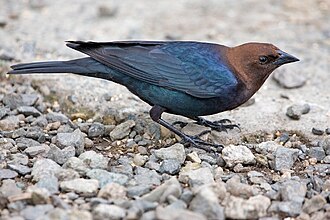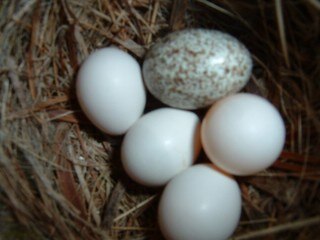Difference between revisions of "Field Guide/Birds/Molothrus ater"
m (62 revisions: re-import from WB, including edit history) |
|||
| (8 intermediate revisions by the same user not shown) | |||
| Line 1: | Line 1: | ||
| − | {{ | + | {{Bird id |
| − | |||
| name = Brown-headed Cowbird | | name = Brown-headed Cowbird | ||
| − | | | + | | latin_name = Molothrus ater |
| − | | | + | | level = 4 |
| − | | | + | | image_1 = Brown-Headed Cowbird.jpg |
| − | | | + | | caption_1 = Male |
| − | | | + | | image_2 = Molothrus ater1.jpg |
| − | | | + | | caption_2 = Female |
| − | | | + | | image_3 = Cowbird egg.JPG |
| − | + | | caption_3 = A Brown-headed Cowbird egg in an Eastern Phoebe nest. | |
| − | + | | description = Adults have a short finch-like bill and dark eyes. The adult male is mainly iridescent black with a brown head. The adult female is grey with a pale throat and fine streaking on the underparts. | |
| − | | | ||
| − | |||
| − | |||
| − | |||
| − | + | Breeding in open or semi-open country across most of North America, this bird is a brood parasite: it lays its eggs in the nests of other small perching birds, particularly those that build cup-like nests, such as the Yellow Warbler. The young cowbird is fed by the host parents at the expense of their own young. | |
| − | + | Brown-headed Cowbirds are permanent residents in the southern parts of their range; northern birds migrate to the southern United States and Mexico. They often travel in flocks, sometimes mixed with Red-winged Blackbirds or European Starlings. | |
| − | + | These birds forage on the ground, often following grazing animals such as horses and cows to catch insects stirred up by the larger animals. They mainly eat seeds and insects. | |
| − | Brown-headed | + | At one time, the Brown-headed Cowbird followed the bison herds across the prairies. Their parasitic nesting behavior complemented this nomadic lifestyle. Their numbers expanded with the clearing of forested areas and the introduction of new grazing animals by settlers across North America. Brown-headed Cowbirds are now commonly seen at suburban birdfeeders. |
| − | + | Brown-headed Cowbird females can lay 36 eggs in a season. Over 140 different species of birds are known to have raised young cowbirds. Host parents may sometimes notice the cowbird egg. Different species react in different ways. Gray Catbirds destroy the egg by pecking it. Some species may simply build a new layer over the bottom of the original nest. Brown-headed cowbird nestlings are sometimes expelled from the nest. | |
| − | + | }}<noinclude>[[Category:Adventist Youth Honors Answer Book/Transcluded Modules|{{FULLCHAPTERNAME}}]]</noinclude> | |
| − | |||
| − | |||
| − | |||
| − | Brown-headed Cowbird females can lay 36 eggs in a season. Over 140 different species of birds are known to have raised young cowbirds. Host parents may sometimes notice the cowbird egg. Different species react in different ways. | ||
| − | |||
| − | < | ||
| − | |||
| − | |||
| − | |||
| − | |||
| − | |||
| − | |||
| − | |||
| − | |||
| − | |||
| − | |||
| − | |||
| − | |||
| − | |||
| − | |||
| − | |||
| − | |||
| − | |||
| − | |||
| − | |||
Latest revision as of 19:13, 5 July 2012
| Molothrus ater (Brown-headed Cowbird) | |
|---|---|
| Description | |
| Adults have a short finch-like bill and dark eyes. The adult male is mainly iridescent black with a brown head. The adult female is grey with a pale throat and fine streaking on the underparts.
Breeding in open or semi-open country across most of North America, this bird is a brood parasite: it lays its eggs in the nests of other small perching birds, particularly those that build cup-like nests, such as the Yellow Warbler. The young cowbird is fed by the host parents at the expense of their own young. Brown-headed Cowbirds are permanent residents in the southern parts of their range; northern birds migrate to the southern United States and Mexico. They often travel in flocks, sometimes mixed with Red-winged Blackbirds or European Starlings. These birds forage on the ground, often following grazing animals such as horses and cows to catch insects stirred up by the larger animals. They mainly eat seeds and insects. At one time, the Brown-headed Cowbird followed the bison herds across the prairies. Their parasitic nesting behavior complemented this nomadic lifestyle. Their numbers expanded with the clearing of forested areas and the introduction of new grazing animals by settlers across North America. Brown-headed Cowbirds are now commonly seen at suburban birdfeeders. Brown-headed Cowbird females can lay 36 eggs in a season. Over 140 different species of birds are known to have raised young cowbirds. Host parents may sometimes notice the cowbird egg. Different species react in different ways. Gray Catbirds destroy the egg by pecking it. Some species may simply build a new layer over the bottom of the original nest. Brown-headed cowbird nestlings are sometimes expelled from the nest. | |



